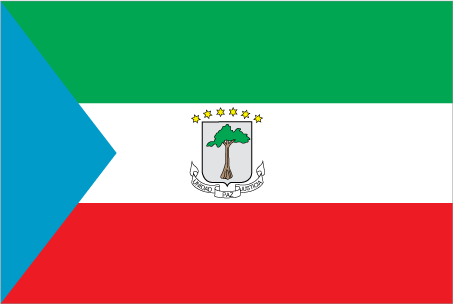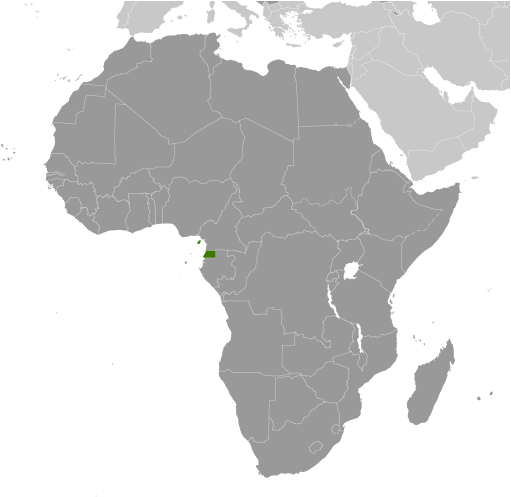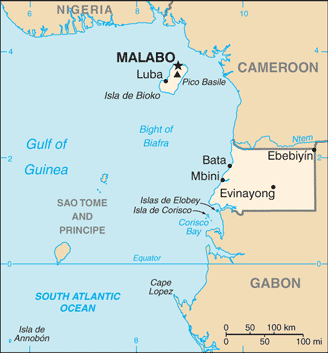
|
|
Advertisements:
EconomyEconomy - overview
The discovery and exploitation of large oil and gas reserves have contributed to dramatic economic growth, but fluctuating oil prices have produced huge swings in GDP growth in recent years. Forestry and farming are also minor components of GDP. Subsistence farming is the dominate form of livelihood. Although pre-independence Equatorial Guinea counted on cocoa production for hard currency earnings, the neglect of the rural economy under successive regimes has diminished potential for agriculture-led growth (the government has stated its intention to reinvest some oil revenue into agriculture). A number of aid programs sponsored by the World Bank and the IMF have been cut off since 1993 because of corruption and mismanagement. The government has been widely criticized for its lack of transparency and misuse of oil revenues; however, in 2010, under Equatorial Guinea's candidacy in the Extractive Industries Transparency Initiative, the government published oil revenue figures for the first time. Undeveloped natural resources include gold, zinc, diamonds, columbite-tantalite, and other base metals. Growth remained strong in 2008, when oil production peaked but fell in 2009-10 as the price of oil and the production level dropped. Growth returned in 2011 stimulated by higher oil prices and large investments in public infrastructure and hotels. Gdp (purchasing power parity) World Ranking: 114
$26.48 billion (2011 est.)
$24.73 billion (2010 est.) $24.92 billion (2009 est.) Note Data are in 2011 US dollars Gdp (official exchange rate)
$19.81 billion (2011 est.)
Gdp - real growth rate World Ranking: 29
7.1% (2011 est.)
-0.8% (2010 est.) 5.7% (2009 est.) Gdp - per capita (ppp) World Ranking: 64
$19,600 (2011 est.)
$18,800 (2010 est.) $19,500 (2009 est.) Note Data are in 2010 US dollars; population figures are uncertain for Equatorial Guinea; these per capita income figures are based on a estimated population of less than 700,000; some estimates put the figure as high as 1.2 million people; if true, the per capita GDP figures would be significantly lower Gdp - composition by sector
Agriculture 3.6%
Industry 89.7% Services 4.3% (2011 est.) Labor force World Ranking: 172
195,200 (2007)
Unemployment rate World Ranking: 169
22.3% (2009 est.)
Population below poverty line
NA%
Household income or consumption by percentage share
Lowest 10% NA%
Highest 10% NA% Investment (gross fixed) World Ranking: 2
49% of GDP (2011 est.)
Budget
Revenues $8.805 billion
Expenditures $8.477 billion (2011 est.) Taxes and other revenues World Ranking: 31
44.5% of GDP (2011 est.)
Budget surplus (+) or deficit (-) World Ranking: 27
1.7% of GDP (2011 est.)
Public debt World Ranking: 142
4.6% of GDP (2011 est.)
5.1% of GDP (2010 est.) Inflation rate (consumer prices) World Ranking: 156
7% (2011 est.)
8.2% (2010 est.) Central bank discount rate World Ranking: 83
8.5% (31 December 2010 est.)
4.25% (31 December 2009 est.) Commercial bank prime lending rate World Ranking: 43
15% (31 December 2011 est.)
15% (31 December 2010 est.) Stock of narrow money World Ranking: 127
$1.936 billion (31 December 2011 est.) $1.889 billion (31 December 2010 est.) Stock of broad money World Ranking: 147
$2.166 billion (31 December 2011 est.) $2.109 billion (31 December 2010 est.) Stock of domestic credit World Ranking: 182
$190.7 million (31 December 2011 est.) $171.8 million (31 December 2010 est.) Agriculture - products
Coffee, cocoa, rice, yams, cassava (manioc), bananas, palm oil nuts; livestock; timber Industries
Petroleum, natural gas, sawmilling Industrial production growth rate World Ranking: 125
1.8% (2010 est.)
Electricity - production World Ranking: 193
92 million kWh (2008 est.)
Electricity - consumption World Ranking: 194
85.56 million kWh (2008 est.)
Electricity - exports
0 kWh (2009 est.)
Electricity - imports
0 kWh (2009 est.)
Oil - production World Ranking: 35
322,700 bbl/day (2010 est.)
Oil - consumption World Ranking: 189
2,000 bbl/day (2010 est.)
Oil - exports World Ranking: 34
395,000 bbl/day (2009 est.)
Oil - imports World Ranking: 181
1,729 bbl/day (2009 est.)
Oil - proved reserves World Ranking: 39
1.1 billion bbl (1 January 2011 est.) Natural gas - production World Ranking: 47
6.27 billion cu m (2009 est.)
Natural gas - consumption World Ranking: 84
1.55 billion cu m (2009 est.)
Natural gas - exports World Ranking: 29
4.72 billion cu m (2009 est.)
Natural gas - imports World Ranking: 186
0 cu m (2009 est.)
Natural gas - proved reserves World Ranking: 69
36.81 billion cu m (1 January 2011 est.) Current account balance World Ranking: 120
-$940.6 million (2011 est.)
-$1.596 billion (2010 est.) Exports World Ranking: 79
$15.64 billion (2011 est.)
$10 billion (2010 est.) Exports - commodities
Petroleum products, timber
Exports - partners
Spain 14.6%, China 13%, Italy 10.8%, Japan 10.5%, US 9.5%, Netherlands 7.5%, Canada 5.5%, Brazil 5%, France 4.7%, South Korea 4.1% (2011) Imports World Ranking: 110
$7.322 billion (2011 est.)
$5.7 billion (2010 est.) Imports - commodities
Petroleum sector equipment, other equipment, construction materials, vehicles Imports - partners
Spain 16.7%, US 12.8%, France 12.1%, China 12%, Italy 6.6%, Cote dIvoire 5.8%, Morocco 4.7% (2011) Reserves of foreign exchange and gold World Ranking: 101
$3.055 billion (31 December 2011 est.) $2.346 billion (31 December 2010 est.) Debt - external World Ranking: 154
$1.051 billion (31 December 2011 est.) $829.1 million (31 December 2010 est.) Exchange rates
Cooperation Financiere en Afrique Centrale francs per US dollar - 471.87 (2011 est.)495.28 (2010 est.) 472.19 (2009) 447.81 (2008) 481.83 (2007) Fiscal year
Calendar year
Comments
Add a new comment: |
Advertisement
Members area
Equatorial Guinea (Malabo):
 
GPS points from Equatorial Guinea (Malabo)
|
||||||||

 Equatorial Guinea gained independence in 1968 after 190 years of Spanish rule. This tiny country, composed of a mainland portion plus five inhabited islands, is one of the smallest on the African continent. President Teodoro OBIANG NGUEMA MBASOGO has ruled the country since 1979 when he seized power in a coup. Although nominally a constitutional democracy since 1991, the 1996, 2002, and 2009 presidential elections - as well as the 1999, 2004, and 2008 legislative elections - were widely seen as flawed. The president exerts almost total control over the political system and has discouraged political opposition. Equatorial Guinea has experienced rapid economic growth due to the discovery of large offshore oil reserves, and in the last decade has become Sub-Saharan Africa's third largest oil exporter. Despite the country's economic windfall from oil production resulting in a massive increase in government revenue in recent years, improvements in the population's living standards have been slow to develop.
Equatorial Guinea gained independence in 1968 after 190 years of Spanish rule. This tiny country, composed of a mainland portion plus five inhabited islands, is one of the smallest on the African continent. President Teodoro OBIANG NGUEMA MBASOGO has ruled the country since 1979 when he seized power in a coup. Although nominally a constitutional democracy since 1991, the 1996, 2002, and 2009 presidential elections - as well as the 1999, 2004, and 2008 legislative elections - were widely seen as flawed. The president exerts almost total control over the political system and has discouraged political opposition. Equatorial Guinea has experienced rapid economic growth due to the discovery of large offshore oil reserves, and in the last decade has become Sub-Saharan Africa's third largest oil exporter. Despite the country's economic windfall from oil production resulting in a massive increase in government revenue in recent years, improvements in the population's living standards have been slow to develop.